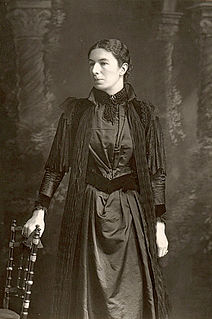
Mary Augusta Ward was a British novelist who wrote under her married name as Mrs Humphry Ward. She worked to improve education for the poor and she became the founding President of the Women's National Anti-Suffrage League.
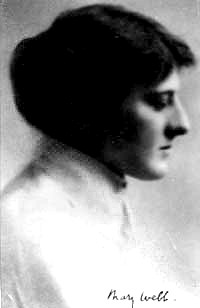
Mary Gladys Webb was an English romance novelist and poet of the early 20th century, whose work is set chiefly in the Shropshire countryside and among Shropshire characters and people whom she knew. Her novels have been successfully dramatized, most notably the film Gone to Earth in 1950 by Michael Powell and Emeric Pressburger based on the novel of the same title. The novels are thought to have inspired the famous parody Cold Comfort Farm (1932) by Stella Gibbons.
Nancy Barbara Bond is an American author of children's literature. In 1977 her first book, A String in the Harp, was fantasy novel with an element of folklore, set in West Wales. It received a Newbery honor and the Welsh Tir na n-Og Award, and remains in print.
Description is the pattern of narrative development that aims to make vivid a place, object, character, or group. Description is one of four rhetorical modes, along with exposition, argumentation, and narration. In practice it would be difficult to write literature that drew on just one of the four basic modes.
Phebe Gibbes was an 18th-century English novelist and early feminist. She authored twenty-two books between 1764 and 1790, and is best known for the novels The History of Mr. Francis Clive (1764), The Fruitless Repentance; or, the History of Miss Kitty Le Fever (1769), and The History of Miss Eliza Musgrove (1769). She received recent attention with the scholarly publication of Hartly House Calcutta (1789) in 2007.
Marion St John Adcock Webb was an English writer of novels and poetry for children that presaged A. A. Milne, with her character "The Littlest One".

In literature regionalism refers to fiction or poetry that focuses on specific features, such as dialect, customs, history, and landscape, of a particular region. The setting is particularly important in regional literature and the "locale is likely to be rural and/or provincial."
John Archibald Webb (1866–1947) was a British painter and illustrator who illustrated over 150 books.

Stay with Me Till Morning is a 1970 novel by the British writer John Braine.
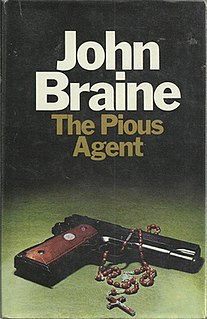
The Pious Agent is a 1975 spy thriller novel by the British writer John Braine.

Seven for a Secret is a 1922 romance novel by the British writer Mary Webb. She wrote to Thomas Hardy asking if she might dedicate the novel to him, to which he agreed. As with her other novels it takes place in her native Shropshire. The title is taken from the traditional nursery rhyme One for Sorrow.
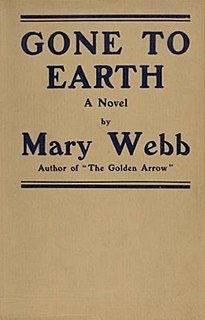
Gone to Earth is a 1917 romance novel by the British writer Mary Webb. It was her second novel following her debut The Golden Arrow the previous year. It received positive reviews and Rebecca West described it as her book of the year. It is set in Shropshire around Long Mynd and Wenlock Edge. In 1935 it was one of the first batch of Penguin Books published.

Paying Guests is a 1929 comedy novel by the British writer E.F. Benson, best known as the author of the Mapp and Lucia series. The story takes place at Wentworth, a boarding house in the fictional resort town of Bolton Spa. It focuses on the eccentric collection of summer residents, mostly there to try and recover their health, overseen by the domineering former Indian Army Colonel Chase. It has been described as "The coming together of character and situation in Paying Guests creates a comic masterpiece, worthy to stand alongside the Mapp and Lucia books".

Lucy Carmichael is a 1951 romantic drama novel by the British writer Margaret Kennedy. It was her tenth published novel. It was well-received by critics but did not repeat the success of her earlier hits The Constant Nymph and Escape Me Never. It was a Literary Guild choice in America. In 2011 it was reissued by Faber and Faber.
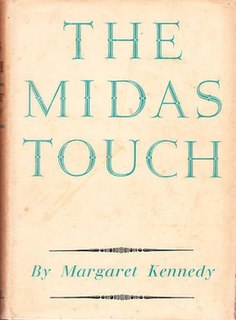
The Midas Touch is a 1938 novel by the British writer Margaret Kennedy. It was her eight novel, she then took a decade-long break before producing her next work The Feast in 1950. It was a Daily Mail Book of the Month.

The Ladies of Lyndon is a 1923 novel by the British writer Margaret Kennedy. Her debut novel, it was rell-received and she followed it the next year with her breakthrough novel The Constant Nymph.
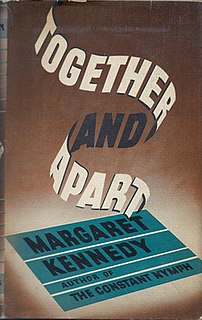
Together and Apart is a 1936 novel by the British writer Margaret Kennedy, her seventh novel. Kennedy was motivated to write it by an increasing number of divorces amongst her acquaintances.

Red Sky at Morning is a 1927 novel by the British writer Margaret Kennedy, her third. Her previous novel The Constant Nymph had been a major critical and commercial success, and it was felt that her new novel failed to recapture this. Sylvia Lynd reviewed it saying "Few novels have so exquisite a forerunner as The Constant Nymph with which to compete. Compared with that, Red Sky at Morning, it must be admitted, is far less moving, less inevitable in the progress of its events, and less well stocked with fascinating characters. Compared with any ordinary novel, however, it is very good indeed - finely wrought, just, sensible, perceptive and witty".

The Feast is a 1949 novel by the British writer Margaret Kennedy. It is a modern reworking of the seven deadly sins. Her ninth novel, it was her first in more than a decade. It was a Literary Guild choice in America.
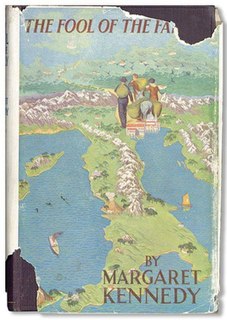
The Fool of the Family is a 1930 novel by the British writer Margaret Kennedy. It is the sequel to her 1924 bestseller The Constant Nymph.















